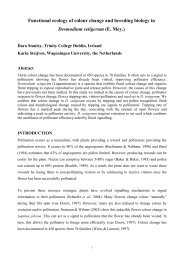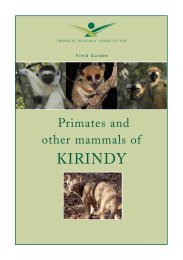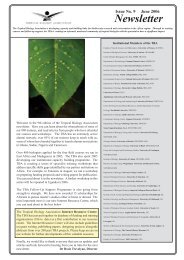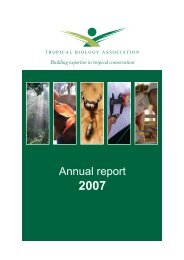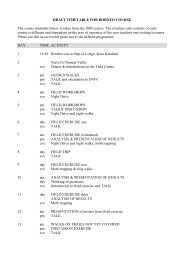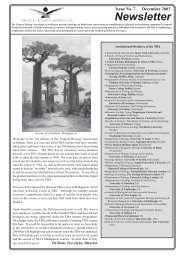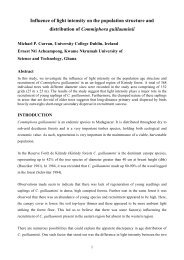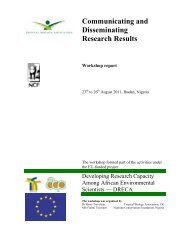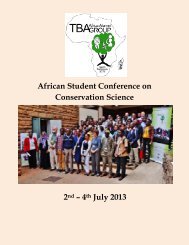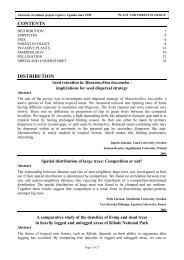Download TAAG Book of Abstracts - Tropical Biology Association
Download TAAG Book of Abstracts - Tropical Biology Association
Download TAAG Book of Abstracts - Tropical Biology Association
Create successful ePaper yourself
Turn your PDF publications into a flip-book with our unique Google optimized e-Paper software.
Analysis <strong>of</strong> Road Kills in Tsavo-East National Park along<br />
Mombasa Nairobi Highway<br />
Joseph Mzozo<br />
Email for correspondence: josephmzozo@gmail.com<br />
Abstract<br />
Highways close to and located within protected areas<br />
have led to high levels <strong>of</strong> animal-vehicle collisions. Tsavo<br />
East National Park is located along the ever busy<br />
Nairobi-Mombasa highway. The highway has led to<br />
killing <strong>of</strong> many wild animals including carnivores,<br />
mammals, birds and reptiles thereby making the area<br />
insecure and unsafe for movement <strong>of</strong> wildlife. The aim<br />
<strong>of</strong> the study is therefore to assess the seasonal<br />
frequency and species <strong>of</strong> road kills in the different<br />
sections <strong>of</strong> the Nairobi-Mombasa highway. The study<br />
was carried out between December 2009 and March<br />
2010. This involved survey <strong>of</strong> carcasses, blood signs and<br />
broken limbs <strong>of</strong> wild animals knocked down by vehicles<br />
along the highway. The survey was carried out through<br />
patrolling with a vehicle at 15km h -1 on the entire length<br />
<strong>of</strong> the 61km highway. At each encounter, the necessary<br />
information about the animal is recorded, GPS <strong>of</strong> the<br />
points was taken and the carcasses were removed to<br />
avoid double counting. Secondary data was also<br />
collected from the Tsavo Research Centre Research<br />
Station. It was discovered that the Mombasa–Nairobi<br />
highway has resulted in high levels <strong>of</strong> animal vehicle<br />
collisions. A total <strong>of</strong> one hundred and one animals killed<br />
were encountered during the survey, mostly carnivores,<br />
herbivores, reptiles, birds and primates respectively.<br />
Carnivores were mostly affected in most <strong>of</strong> the<br />
observed cases. On the overall, dry season recorded<br />
high number <strong>of</strong> road kills. It was recommended that<br />
mitigation measures should be put in place such as sign<br />
posts, and both crossings on straight and curved<br />
sections to reduce animal vehicle mortality through<br />
speeding vehicles.<br />
Keywords: Animal, vehicle, collisions, seasonal<br />
frequency.<br />
Bird Species Diversity and Abundance on Farmlands<br />
Surrounding Amurum Forest Reserve, Jos, Nigeria<br />
1,2 *Kambai Collina, 2 Ulf Ottosson, 2,3 Dami F. Danjuma<br />
1 Federal College <strong>of</strong> Forestry, Jos, Nigeria<br />
2 A.P Leventis Ornithological Research Institute, Amurum<br />
Forest Reserve, Jos, Nigeria<br />
3 University <strong>of</strong> Jos, Nigeria<br />
*Email for correspondence: talk2nev@yahoo.com<br />
Abstract<br />
Increasing demand for agricultural lands to ensure food<br />
security due to the growing human population has<br />
resulted in massive degradation, fragmentation and loss<br />
<strong>of</strong> natural forests. This study was conducted to<br />
understand the farmland type that bird species are<br />
associated with in a bid to ensure their conservation.<br />
Four habitat types – farmland with trees (FWT),<br />
farmland without trees (FWOT), rocky outcrop (RO) and<br />
fallow farmlands (FF) were surveyed using line transect.<br />
Bird survey was carried out in 435 transect <strong>of</strong> 100<br />
metres each chosen using stratified random sampling.<br />
The rank abundance <strong>of</strong> the bird species was determined<br />
by the proportions <strong>of</strong> the occurrence <strong>of</strong> each bird<br />
species in each <strong>of</strong> the farmland type. Post-hoc test was<br />
used to determine if differences in bird species diversity<br />
and abundance between each pair <strong>of</strong> farmland types<br />
were significant. Shannon diversity index was used to<br />
calculate bird diversity. Results show that presence <strong>of</strong><br />
shrub, water, hedgerow and trees were highly<br />
significant in predicting bird species richness. There was<br />
no significant difference in bird abundance, diversity<br />
and richness between FWT, FF and RO, but there was a<br />
high significant difference in FWOT. FWT had the<br />
highest bird abundance and diversity while FWOT had<br />
the least. Moreover, the presence <strong>of</strong> trees rather than<br />
number <strong>of</strong> trees found on farmland is an important<br />
predictor <strong>of</strong> bird species richness and this must be<br />
understood in order to incorporate it into conservation<br />
management plans. Birds with varying fielding guilds<br />
which poses less threat to crop yield was high in FWT<br />
while FWOT had high numbers <strong>of</strong> granivorous birds that<br />
are harmful to crop yield. Economic trees could be<br />
planted, which conserves bird species on farmland,<br />
performs its role in ecosystem functioning and<br />
generates income to the farmer.<br />
Keywords: Conservation, Bird species diversity,<br />
Abundance, Farmland, Vegetation<br />
<strong>TAAG</strong> First African Student’s Conference, Nairobi. 2-4 July, 2013 19




